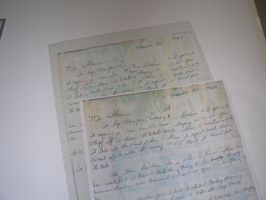Tuesday, June 30, 2009
While processing manuscript archive documents from the African American Museum of Iowa we fortuned upon an old, mysterious and extremely problematic form of document duplication.
What we believe we have, perhaps hundreds of, are adherography documents. A definition, found in “Guide to the identification of prints and photographs : featuring a chronological history of reproduction technologies” – a supplement to the book “Encyclopedia of printing, photographic and photomechanical processes,” by Luis Nadeau, 2002 – is as follows:
 ADHEROGRAPHY: A duplicating process developed by 3M. Images were formed by the adherence of powder to a tacky latent image created by the effect of infrared heat. This provided a master from which 200 to 250 copies could be made. The powder image of the resulting print was fused to the paper by heat. [A process used during the 1960’s.]
ADHEROGRAPHY: A duplicating process developed by 3M. Images were formed by the adherence of powder to a tacky latent image created by the effect of infrared heat. This provided a master from which 200 to 250 copies could be made. The powder image of the resulting print was fused to the paper by heat. [A process used during the 1960’s.]
These adherographs, recognized as inherently volatile, did not respond well to the moisture, humidity, and high temperatures generated by last June’s floods. The powder image described above, once fused to a slick-feeling, glossy-looking paper carrier, have lost their bind to their paper hosts.
Reformatting is simple where the powder images free themselves in large pieces. Unfortunately, many of the documents have experienced a shattering of the powder image layer. Attempts to stabilize these particular documents in sonically-welded Mylar encapsulations have both pros and cons. On one hand, the Mylar, having a strong static charge, lock the powder image fragments into place… useful for reformatting. On the other hand, this same static charge has the tendency to agitate the fragments into incomprehensible disorder.
With the jury still out on encapsulation, we simply reformat through the best possible means. Where the documents are relatively stable, we quickly scan them face down on the Ricoh. Where the documents are highly volatile, we image them under the Zeutschel top-down scanner. No digital files are maintained. Determining the best solution for the shattered documents requires further research. Stay tuned.